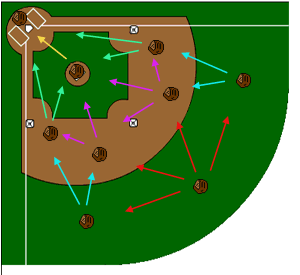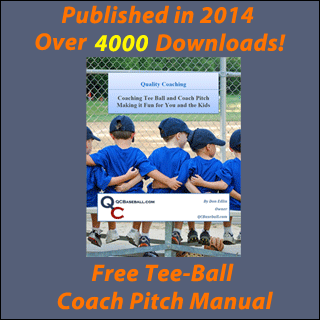Defensive Fly Ball Communication
Who's In Charge? - Teaching Fly Ball and Pop-up Fielding Priority
A fly ball is hit to left-center, who calls for it? How do the two players determine who has priority? This situation can occur in many places on the field involving any position on the field and can sometimes result in a collision or more often having two players looking at each other as the ball drops to the ground between them. A more difficult situation is a ball hit over the shortstop or second baseman's head. Now you could have 3 players involved. How about a pop-up to the infield around the mound? Maybe 3 or 4 players could make the play. Getting your team prepared for these situations is something you can work on in practice, but first you need to have a communication system in place.
In order to prevent confusion in these situations it's important to teach your team:
- Which positions are in charge and able to call off other players. (Priority)
- Different set of commands for the player who's in charge and those who aren't. (Commands)
- Confirmation call from the player not making the play. (Confirmation)
1. Priority
 The priorities for a fly ball start with the center fielder having complete control over everyone on the field and then moving in. The basic premise is to have the player moving in on the fly ball have control and the ability to call off the other player. If you look at the diagram below you'll see the arrow pointing from each player to the other players that he can call off. All outfielders have the ability to call off all infielders. The shortstop has the ability to call off all other infielders but not outfielders. If he is moving back into the outfield then he has to give up priority to the outfielder coming in on the ball. All infielders have the ability to call off the pitcher*.
The priorities for a fly ball start with the center fielder having complete control over everyone on the field and then moving in. The basic premise is to have the player moving in on the fly ball have control and the ability to call off the other player. If you look at the diagram below you'll see the arrow pointing from each player to the other players that he can call off. All outfielders have the ability to call off all infielders. The shortstop has the ability to call off all other infielders but not outfielders. If he is moving back into the outfield then he has to give up priority to the outfielder coming in on the ball. All infielders have the ability to call off the pitcher*.
Following up on the coaching advise above, you'll notice in the diagram that I have the pitcher being able to call off the catcher. This really is an age/skill thing. In higher levels of baseball the pitcher will rarely catch a pop fly, but for younger players the reality is that the pitcher will often have a much better chance than the catcher to catch any pop fly hit in front of him. It's a difficult skill for the catcher to learn to catch a fly ball out in front of the plate, so until you know you have a catcher that can do it, I would give the pitcher priority.
2. Commands
Having each player yelling "I got it" doesn't really help determine who has priority when there is more than one fielder who can catch the ball. To reduce that confusion you can teach the players who have priority to use a different call. I use "Get out" for the fielder who has priority. So if a ball is hit into shallow left field, the shortstop going back on the ball would yell, "I got it". The left fielder coming in would have priority and would yell, "Get out". Anyone who has called for the ball and hears "Get out" should immediately give way to the other fielder.
3. Confirmation
Another useful call is to confirm to the other fielder that he has it. So, using the same example the shortstop is going back on the ball and calls "I got it". As he is getting close to the ball he hears the center fielder running hard towards him. His natural reaction will be to worry about the center fielder running into him. He may catch the ball or he may slow down and have it drop behind. The chance of this happening can be reduced if the center fielder can give a call to confirm that the shortstop is the one who is going to catch the ball. We do this by having the other fielder confirm with "You, you, you". When a player that has yelled "I got it" or "Get out", hears "You, you, you" from the other player, he can be confident in making the play.

Related Baseball Drills
Shallow Fly Balls
Fly Ball Communication
Most Recent Blog Posts
Working With Players on Focusing on the Correct Part of the Baseball when Hitting (October 15 2016)
Getting More Accurate Throws From Your Team (April 5 2016)
Youth Coaching Advice
In higher levels of baseball you'll see where coaches don't want the pitcher to try and catch any fly balls if an infielder can get to it. This makes sense on a towering pop-up with a pitcher that hasn't been practicing catching fly balls. Let the better fielding infielder make the play. In youth baseball you don't want to be this strict as infield pop-ups are not always high enough or the infielders quick enough to call of the pitcher. In addition, many times in youth baseball the pitcher tends to be one of the better athletes and the player you would want to catch the ball. So instruct your infielders to only call off the pitcher if the pitcher is going back. Don't call him off if it's an easy play for him coming forward. One reason to give them is that it's easy to trip over the mound if you're running in from an infield position to catch a pop-up in front of the mound.
Just wanted to say Thank you for the great website. Great information for this new coach. It sounds like baseball gave a lot to your life, so thanks for giving back to baseball.
- Ray K.







